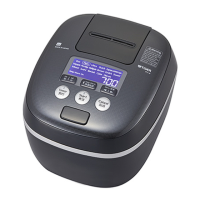37
36
37
36
37
36
13
Cleaning and Maintenance
English
Inner lid
Front side
Safety valve
Pressure
adjusting holes
Inner lid
gasket
Gasket for depressurization
Back side
Pressure adjusting balls
Pressure reducing
hole
Safety valve
Removing/attaching the inner lid (See
P.38)
(1)
Wash it well using a sponge with detergent
diluted with cold or lukewarm water.
(2)
Wipe o the water using a dry cloth and
completely dry all parts.
Condensation can be formed more easily on the dirty
inner lid.
Pressure adjusting holes, pressure adjusting balls, and
pressure reducing hole
Remove any cooked rice or grains of rice adhering to them.
Wash them well under running water.
Safety valve
From the surface of the inner lid, lightly push it a few times with
your nger. Remove any cooked rice or grains of rice adhering
to it.
Front side
Push the safety valve a few
times to check for clogging
and wash the inside under
running water.
Gasket for depressurization
Keep it attached to the inner lid during washing.
If it comes o, match the direction and attach it. (See P.38)
Inner lid gasket
Do not pull the inner lid gasket. Keep it attached to the inner lid
during washing. If it comes o, contact the place of purchase.
Note
● Be sure to remove any cooked rice or grains of rice adhering
to the inner lid. Any rice on the inner lid can prevent the
lid from closing, allow steam to leak out during cooking,
or enable the lid to open and the contents to spray out,
resulting in burns or other injury.
● Be sure to clean the inner lid after cooking rice with barley
or other grains. Otherwise the inner lid may be clogged,
causing a problem like the lid does not open or rice cannot
be cooked properly.
● If there is any signicant food staining, soak the part in
lukewarm water.
● Thoroughly wipe the inner lid using a dry cloth after cleaning
it so that no moisture remains in any gaps. Otherwise, water
drops may leave marks on the inner lid.
● After cleaning the inner lid, check that the gasket for
depressurization is attached rmly. (Attach the gasket if
detached. See P.38)
Parts to wash when dirty
Stoppers
Inner lid
button
Steam
sensor
Lid gasket
Lid
Upper
casing
Center
sensor
Hooks
Upper casing
rubbers
Inside and outside the rice cooker
Wet a cloth, wring out excess water, and wipe.
Stopper, lid gasket, hook, and upper casing
Remove any cooked rice or grains of rice, etc.
Stopper
Steam sensor
Lightly wipe using a moistened cloth or cotton swab.
Center sensor
Remove any burned rice and other adhering grains of
rice.
If adhering objects are hard to remove, use a
commercially available sandpaper (around #320), then
wet a cloth, wring out excess water, and wipe.
Note
● Do not allow water to get inside the rice cooker unit.
● Do not pull on the lid gasket.
Once it is detached, it cannot be reattached. When the
gasket comes o, contact the place of purchase.
Air inlet and air outlet
Air outlet
Air inlet
Remove dust using a cotton swab.
Note
● Do not use the rice cooker if dust is adhering to the air
inlet or outlet.
Otherwise the temperature increases inside the rice
cooker, resulting in malfunction or re.
Power plug and appliance plug
Wipe using a dry cloth.
Note
● Do not immerse the power cord in or splash it with
water. Doing so may cause short circuits, electric
shock, or malfunction.

